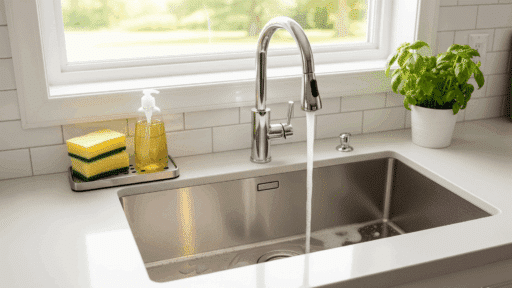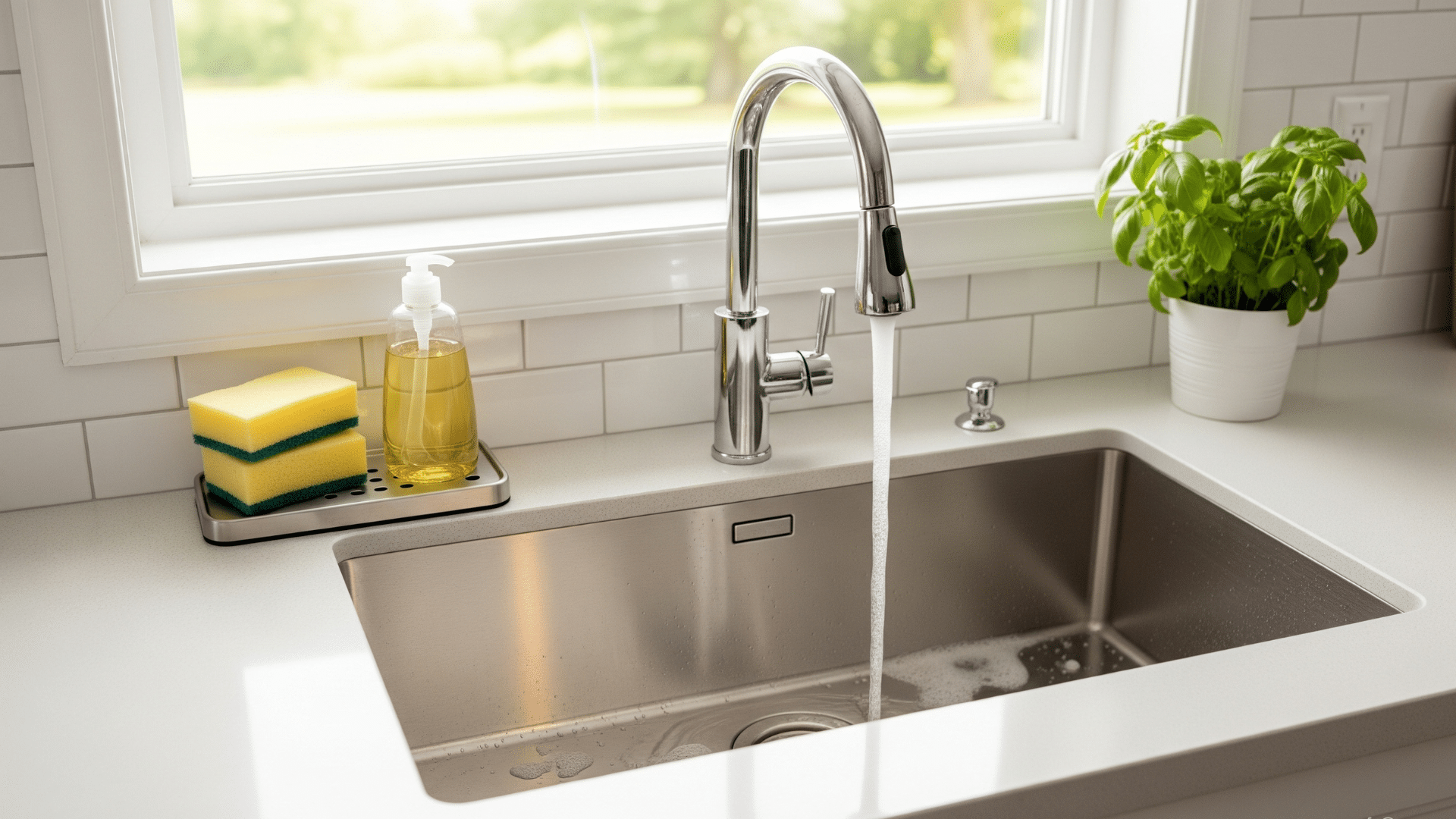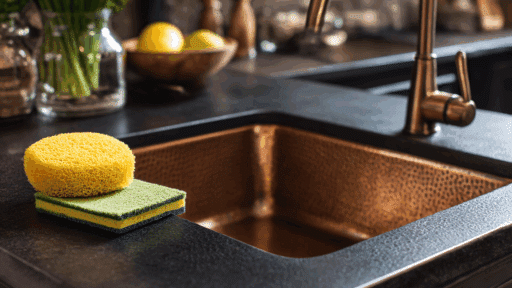I never gave much thought to my kitchen sink until it started acting up. That’s when I realized how little I actually knew about the parts of a kitchen sink working behind the scenes.
Your sink isn’t just a bowl with a faucet. It’s actually a complex system of interconnected components, each playing a crucial role in your daily kitchen routine.
From the obvious parts you see every day to the hidden mechanisms underneath, understanding these sink parts can save you time, money, and frustration when problems arise.
Let me walk you through everything you need to know.
Features and Functionality of Kitchen Sink Parts
Each part of a kitchen sink plays a unique role, from directing water flow to managing waste and preventing leaks.
1. Faucet
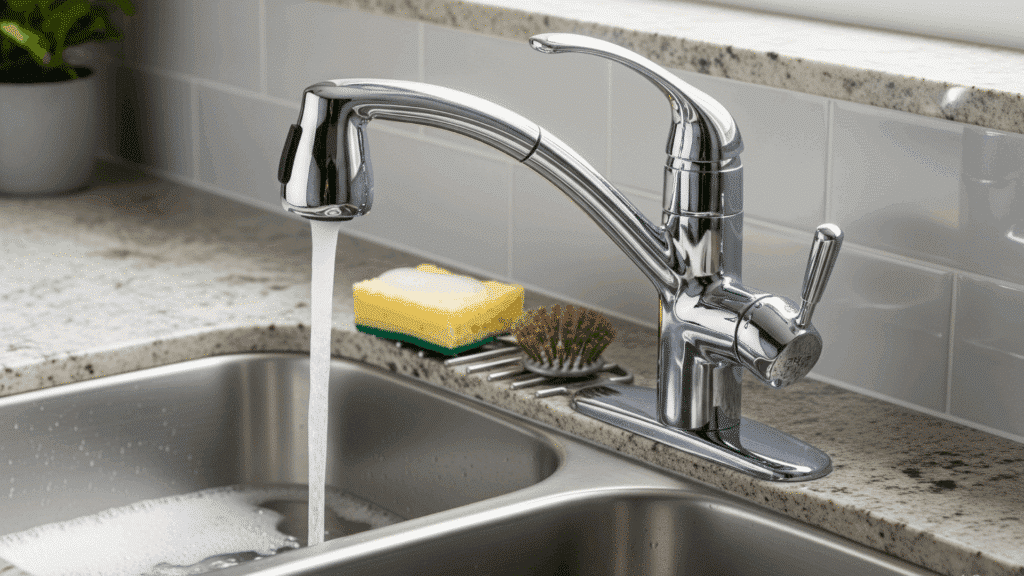
The faucet is the central source of water flow, available in various styles like single-handle, double-handle, pull-out, and touchless. Inside, aerators and cartridges regulate pressure, flow, and temperature control.
- Feature: Comes in pull-out, pull-down, and single/multi-handle designs for user convenience.
- Function: Cartridges mix water and aerators prevent splashing while maintaining water pressure.
- Recommendation: Check out the FORIOUS Black Kitchen Faucet for your kitchen sink here.
2. Sprayer
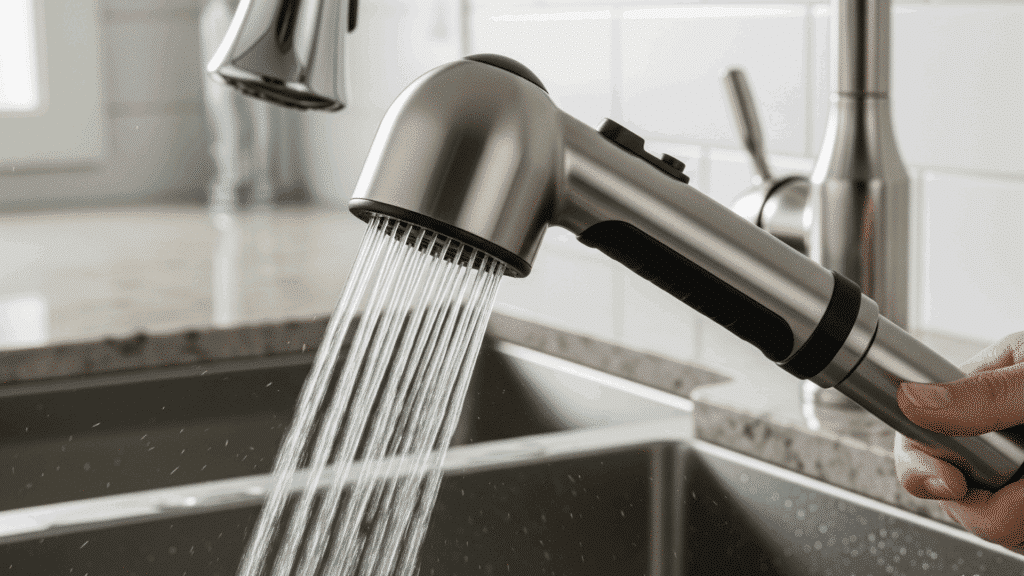
Sprayers are detachable or side-mounted nozzles used for rinsing produce, cleaning dishes, and targeting hard-to-reach corners. They can be built into the faucet or mounted separately.
- Feature: Pull-down and side-sprayer options offer flexible water direction and mobility.
- Function: Enhances washing efficiency with robust and targeted spray control.
- Recommendation: Check out the Market Single-Handle Pull-Down Spray Head for your kitchen sink here.
3. Sink Basin
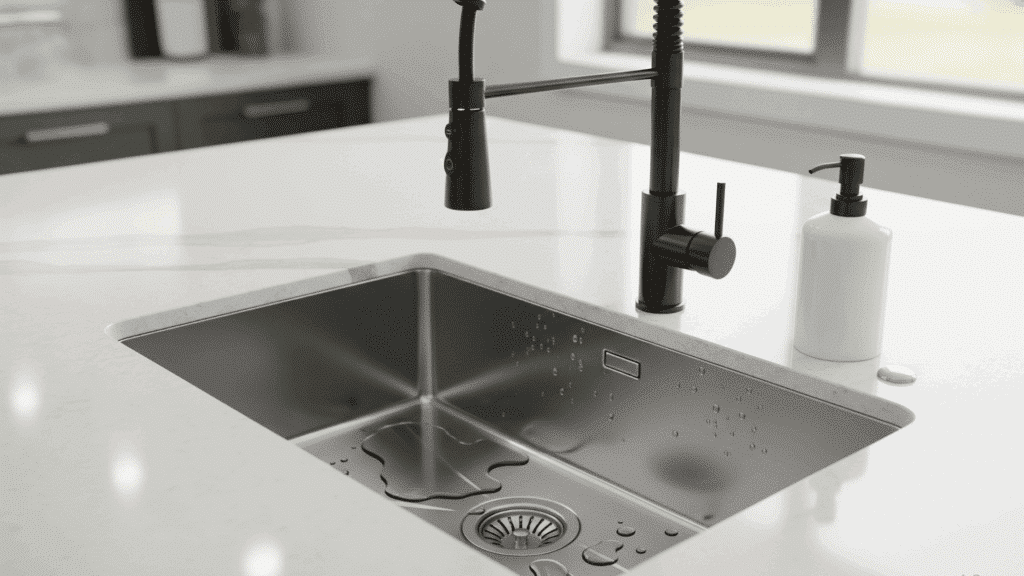
The sink basin is the primary area where washing occurs. It’s available in single- or double-bowl configurations and made from materials such as stainless steel, granite composite, or porcelain.
- Feature: Available in various depths, widths, and noise-reducing materials.
- Function: Holds water for dishwashing or food prep and channels it toward the drain.
- Recommendation: Check out the KRAUS Kore 33″ Undermount Workstation 16 Gauge for your kitchen sink here.
4. Sink Strainer Basket
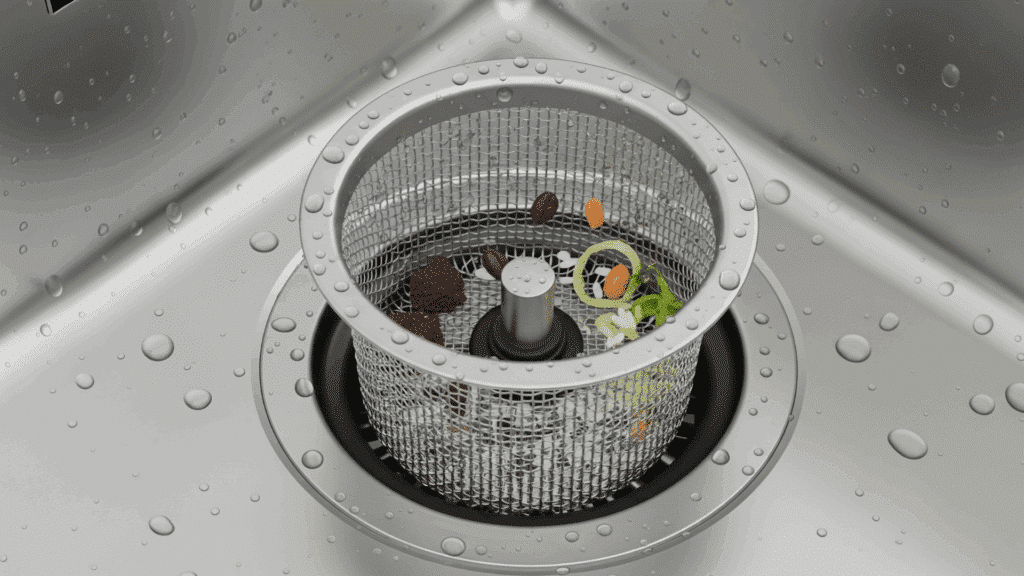
This component fits into the drain opening to catch food scraps and debris, preventing blockages in the plumbing system while allowing water to flow freely.
- Feature: Removable and easy to clean; often includes a stopper for holding water.
- Function: Acts as the first line of defense against drain clogs and sink backups.
- Recommendation: Check out the 2 Pcs Sink Strainer for Most Kitchen Sink Drain Basketfor your kitchen sink here.
5. Drain Assembly
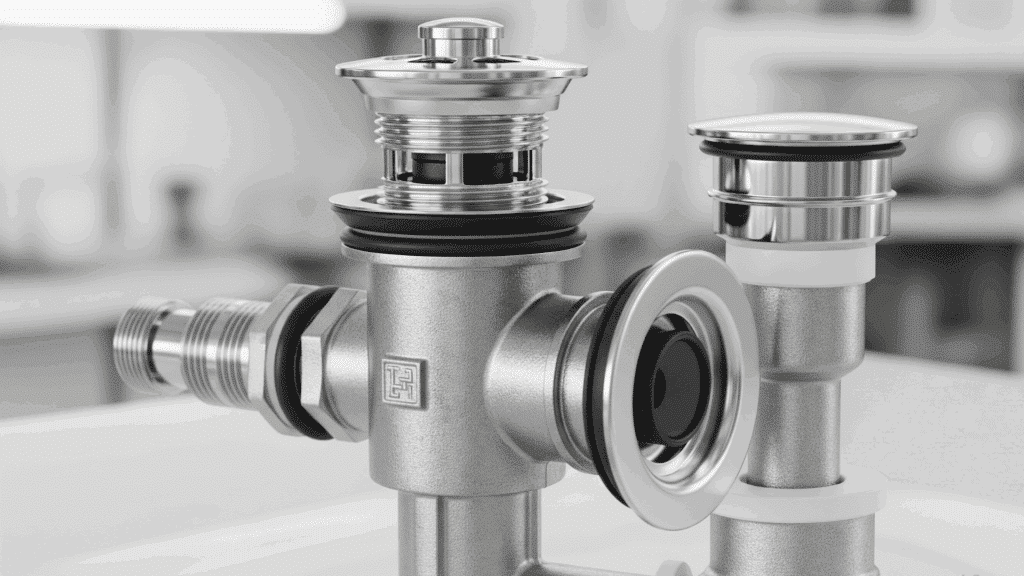
The drain assembly is a system of fittings that connects the sink basin to the household plumbing. It includes the tailpiece, locknut, washer, and strainer body.
- Feature: Universal designs fit most kitchen sinks; materials are available in metal or PVC.
- Function: Directs used water from the strainer to the P-trap while preventing leaks.
- Recommendation: Check out the 3-1/2 Inch Sink Drain Assembly Kit for your kitchen sink here.
6. P-Trap
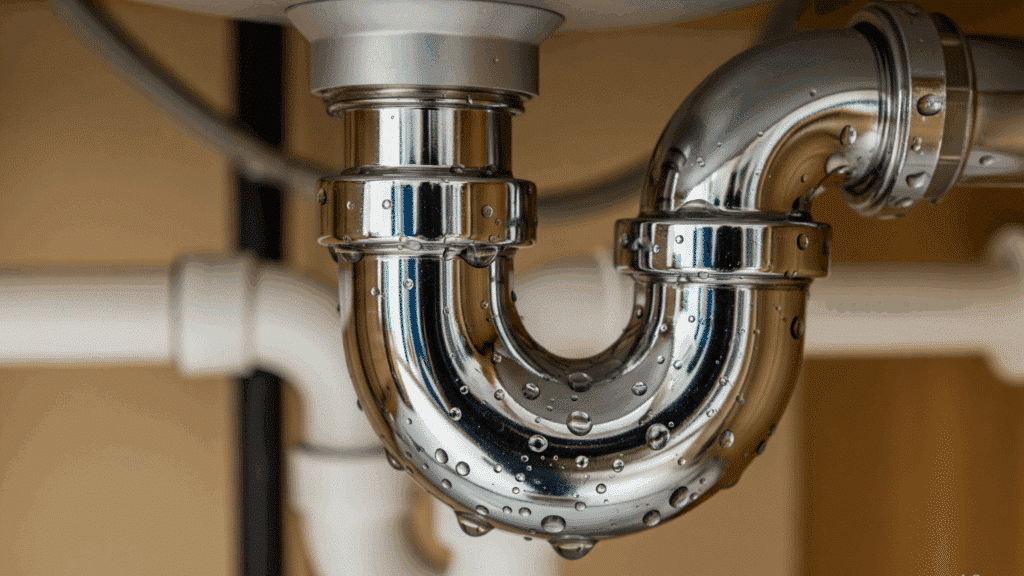
The P-trap is a curved pipe located directly below the drain. It contains a small amount of water, which blocks sewer gases from entering your home through the sink.
- Feature: U-shaped curve traps water and debris, allowing for easy clog retrieval.
- Function: Prevents harmful odors by creating a water seal between plumbing and open air.
- Recommendation: Check out the 1-1/4″ Black Plastic P-Trap for Kitchen Sink Tubular Drain for your kitchen sink here.
7. Trap Arm
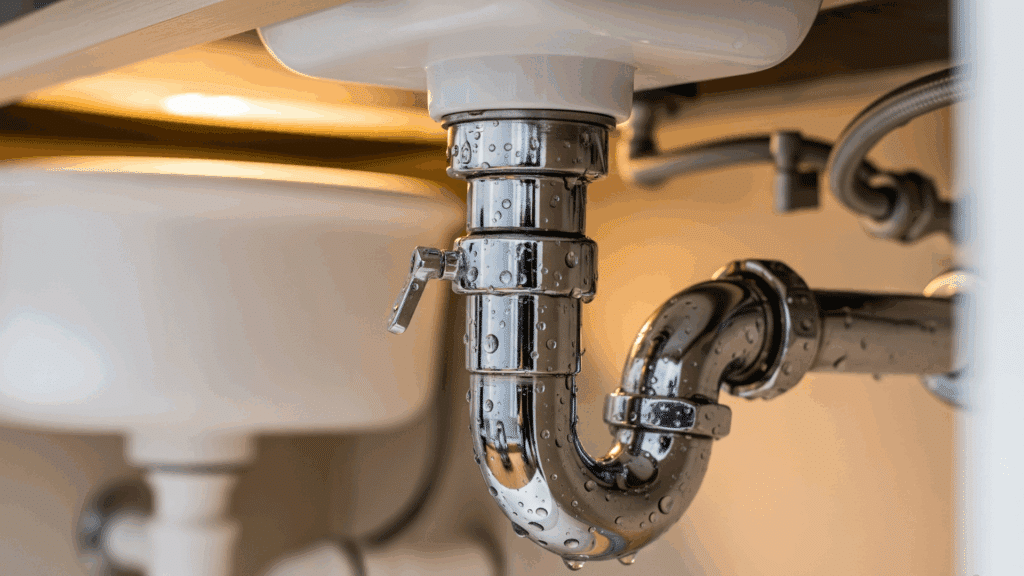
This horizontal pipe links the P-trap to the household drainpipe in the wall. It helps maintain the correct angle and flow of wastewater.
- Feature: Adjustable in length and angle to ensure proper slope for optimal drainage.
- Function: Guides wastewater from the P-trap into the main drainage line.
- Recommendation: Check out the NiHome Flexible 1 1/2″ or 1 1/4″ P-Trap Pipe Kit for your kitchen sink here.
8. Garbage Disposal
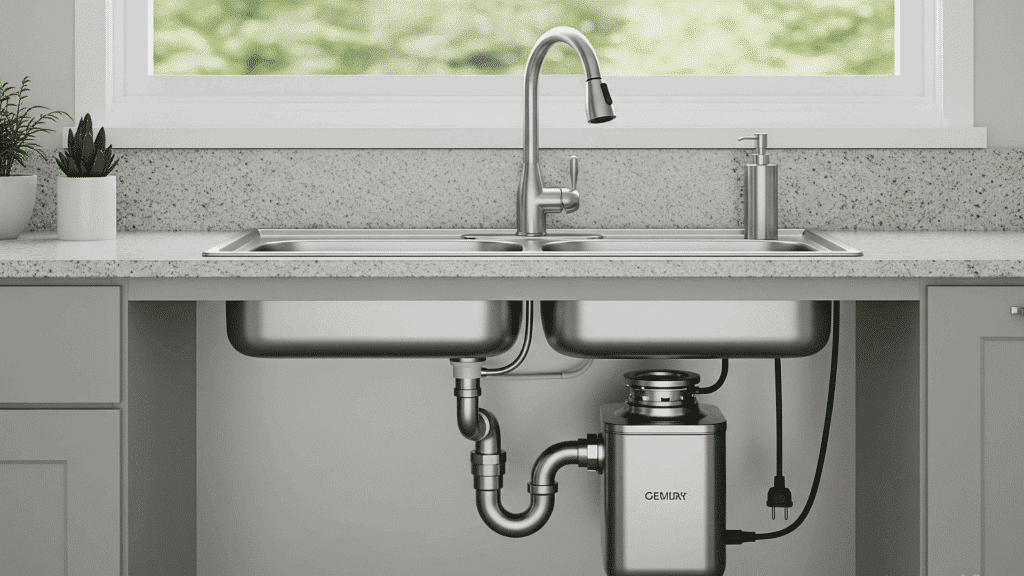
A motorized unit that grinds food waste into tiny particles, allowing it to be flushed safely into the plumbing system. Installed directly beneath the drain opening.
- Feature: May include sound insulation and overload protection.
- Function: Reduces food waste volume and keeps the kitchen smelling fresh.
- Recommendation: Check out the TurboGrind Max 1 hp. Continuous Feed Garbage Disposal with Power Cord for your kitchen sink here.
9. Air Gap
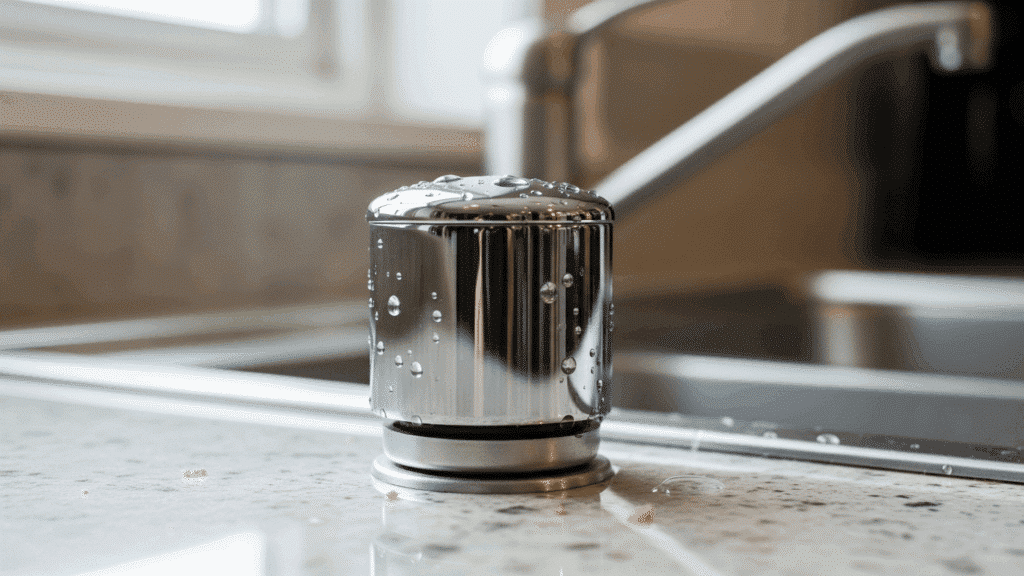
Installed on the sink or countertop, the air gap prevents dirty water from the dishwasher from flowing back into the sink or clean water lines.
- Feature: Small cylindrical device visible above the counter near the faucet.
- Function: Provides a physical gap to eliminate backflow contamination.
- Recommendation: Check out the Dishwasher Air Gap in Spot Free Antique Champagne Bronze for your kitchen sink here.
10. Shut-off Valves
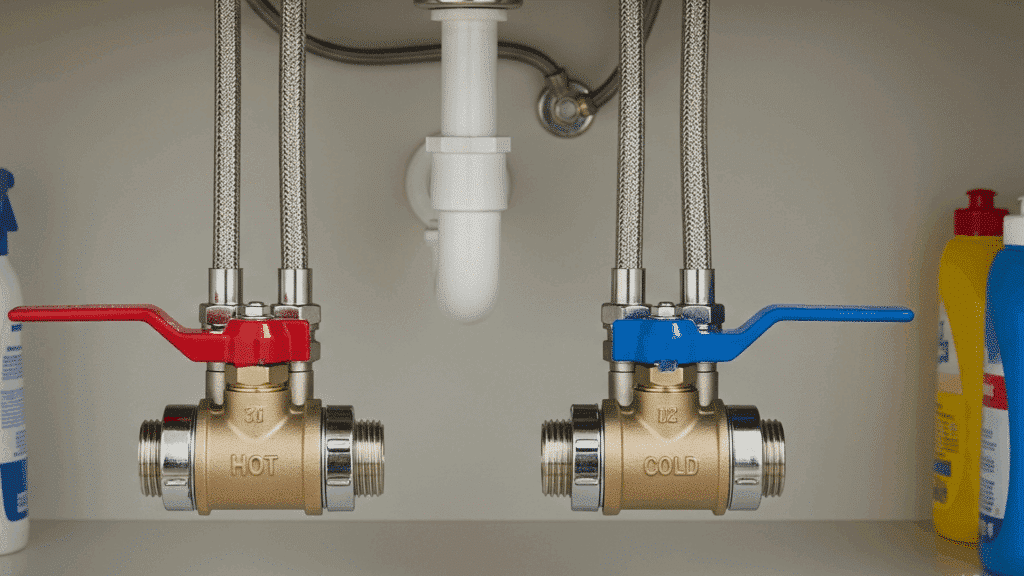
These small knobs or levers control water flow to the hot and cold supply lines, located beneath the sink for easy access during repairs or emergencies.
- Feature: Quarter-turn valves are standard for fast shutoff.
- Function: Enables quick isolation of the water supply without affecting the rest of the house.
- Recommendation: Check out the 1/2 in. FIP Inlet x 3/8 in. Compression Outlet 1/4-Turn Angle Valve for your kitchen sink here.
11. Dishwasher Drain Hose
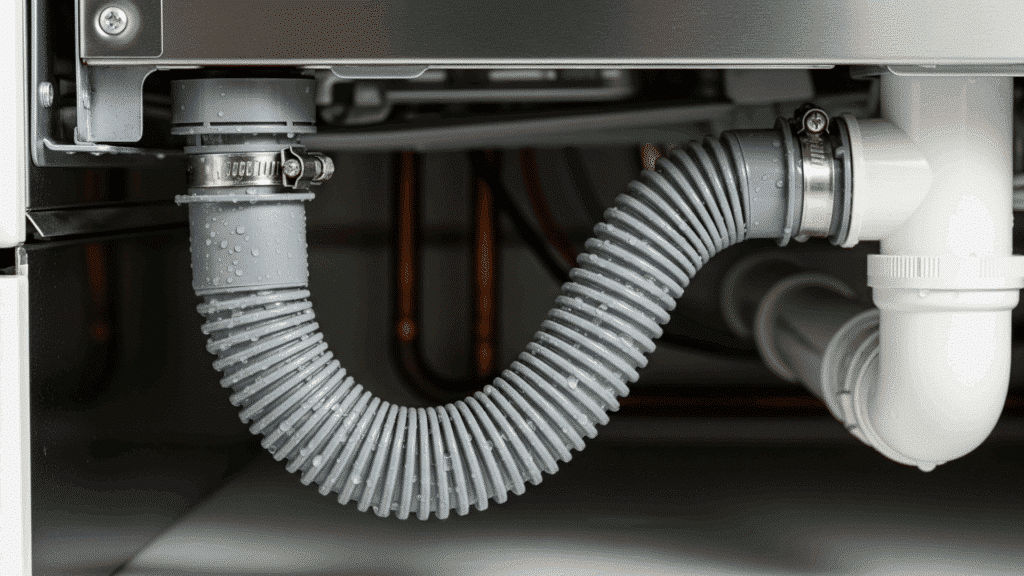
Connects the dishwasher’s wastewater outlet to either the garbage disposal or sink drain assembly, ensuring safe and sanitary water removal.
- Feature: Flexible, corrugated tubing with secure clamps to prevent leaks.
- Function: Channels water from the dishwasher into the plumbing system.
- Recommendation: Check out the Gadpiparty Dishwasher Drain Hose 0.5m Extension Water Hose for your kitchen sink here.
How Kitchen Sink Parts Work Together
I used to think water just magically flowed in and out of my sink. But understanding how all the parts of a sink work together actually makes everything clearer.
The Water Flow Process
When you turn your faucet, pressurized water travels through the supply lines and out the aerator, which mixes air to achieve a smooth flow.
Water hits the basin, flows to the drain via gravity, and passes through the strainer basket to catch debris.
The Drainage System
Water enters the drain assembly and the P-trap, that curved pipe that prevents sewer gases from backing up. From there, it continues through the tailpiece to your home’s main drainage system.
Integration Points
Dishwashers connect through high loops or air gaps to prevent backflow. Garbage disposals replace the standard strainer and grind waste before sending it down the same path.
What Makes It Work
Three forces power your system: water pressure pushes fresh water in, gravity pulls waste out, and the P-trap’s design maintains a protective water seal. Premium sinks add soundproofing and insulation to reduce noise and prevent condensation.
When these kitchen sink parts work together properly, you get seamless daily function without a second thought.
Typical Kitchen Sink Plumbing Issues and Repairs
Kitchen sink plumbing is a complex system of interconnected parts that manage water flow and drainage.
Understanding how these components work together helps ensure smooth operation and prevents future disruptions in your kitchen’s functionality.
| Problem | Affected Parts | Fix/Replace Steps |
| Leaky Faucet | Faucet Cartridge, O-Rings, Washer Seals | Firstly, shut off the water supply under the sink. Then disassemble the faucet handle and spout, replace worn cartridge or O-rings, and reassemble and test for leaks. |
| Slow Drain | P-Trap, Strainer Basket | Unscrew and remove the P-trap to inspect for clogs. Then, clean or replace the strainer basket. Use a drain snake for deeper blockages. |
| Bad Odor from Sink | P-Trap, Garbage Disposal | Run water to refill a dry P-trap. Then, clean disposal with ice, citrus peels, or a baking soda and vinegar flush to remove bacteria and buildup. |
| Loose Faucet Handles / Nozzle | Faucet Mounting Nut, Handle Screws, Cartridge | Tighten mounting hardware under the sink with a basin wrench and remove the handle cap to tighten the screws. Then, replace the cartridge if dripping persists. |
| Backed-Up Dishwasher | Air Gap, Dishwasher Drain Hose | Remove and clean the air gap cap with a small brush, and flush the drain hose with hot water or compressed air. Then, replace the hose if it is kinked, brittle, or blocked. |
Maintenance Tips for Kitchen Sink Parts
I learned the hard way that a bit of prevention beats expensive repairs every time.
Taking care of your kitchen sink parts doesn’t require much effort, but it makes a massive difference in how long everything lasts. Here’s my simple routine that keeps everything running smoothly.
- Monthly inspections: Check under your sink for water spots or dampness around connections. Feel gaskets around the faucet base and sprayer; they should be firm, not squishy or cracked.
- Clean aerators regularly: Unscrew your faucet aerator every few weeks and soak it in white vinegar overnight. This removes mineral deposits that clog those tiny holes, restoring full water flow.
- Descalve faucets: Wipe down your faucet with vinegar to prevent hard water spots and mineral buildup. It’s much easier than scrubbing later.
- Maintain your P-trap: When drains run slow, place a bucket underneath and unscrew the slip nuts by hand to clean out gunk. It’s messy but way cheaper than calling a plumber.
- Prevent problems: Never pour grease down the drain, keep coffee grounds and eggshells out of the disposal, and grind ice cubes with citrus peels monthly to naturally clean disposal blades.
Conclusion
Understanding the parts of a kitchen sink changes you from a confused homeowner into someone who can tackle problems head-on.
I’ve walked you through everything from basic components to how they work together, plus the maintenance that keeps them functioning properly.
If you’re dealing with a slow drain, planning a kitchen upgrade, or just curious about what’s happening beneath your countertop, you now have the knowledge to make informed decisions.
Next time something goes wrong, you won’t be calling for help blindly; you’ll know exactly which sink parts to check first.
Frequently Asked Questions (FAQ’s)
What are Sink Accessories?
Choose from sink grids, drain mats, disposer flanges/trims, basket strainers, soap dispensers, cutting boards, colanders, installation kits, protectants, and more. Ensure to check the compatibility of the accessory with your sink.
What is a Sink Valve Called?
Shutoff valves under the sink, also called fixture shutoffs or stop valves, allow you to turn off the water to your sink (or other fixtures) without using your home’s main shutoff.
How to Fill Kitchen Sink Gaps?
Start at one corner of the sink and work your way around. Pull the gun toward you, maintaining a relaxed, confident grip and steady speed to apply the bead smoothly. If you can’t make it in one pass, it’s ok to readjust your grip and start where you left off. Fill gaps with additional sealant as needed.

